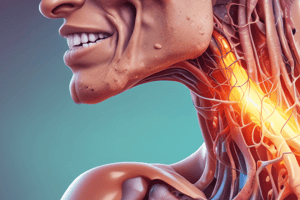Podcast
Questions and Answers
Which pathogen primarily affects goats and is associated with lifelong infection?
Which pathogen primarily affects goats and is associated with lifelong infection?
- Caprine Arthritis and Encephalitis Virus (CAEV) (correct)
- Borrelia spp.
- Clostridium spp.
- Actinomyces spp.
What are the common clinical signs associated with CAEV?
What are the common clinical signs associated with CAEV?
Arthritis, Encephalitis, Pneumonia, Mastitis, Weight loss
There is a vaccine available for Caprine Arthritis and Encephalitis Virus (CAEV).
There is a vaccine available for Caprine Arthritis and Encephalitis Virus (CAEV).
False (B)
CAEV can be transmitted from dam to kid through ______.
CAEV can be transmitted from dam to kid through ______.
What is the recommended temperature and time for pasteurizing milk to reduce CAEV transmission?
What is the recommended temperature and time for pasteurizing milk to reduce CAEV transmission?
Which of the following bacteria are associated with diseases in animals? (Select all that apply)
Which of the following bacteria are associated with diseases in animals? (Select all that apply)
What disease is caused by Actinomyces bovis in cattle?
What disease is caused by Actinomyces bovis in cattle?
Actinomycosis is a contagious disease.
Actinomycosis is a contagious disease.
Flashcards are hidden until you start studying
Study Notes
Infectious Diseases of the Musculoskeletal System
- Focus on key pathogens affecting goats and sheep, including viral, bacterial, and parasitic pathogens.
Viral Pathogen: Caprine Arthritis and Encephalitis Virus (CAEV)
- Lentivirus causing lifelong infection, no vaccine available.
- Primarily affects goats, also present in sheep, common in industrialized dairy goat populations.
CAEV Transmission
- Transmitted from dam to kid through colostrum/milk and close contact.
- Potential for horizontal transfer via fomites.
CAEV Clinical Signs
- Approximately 70-80% of infected goats remain asymptomatic.
- Symptoms may include arthritis, encephalitis (more common in kids), pneumonia, mastitis, and weight loss.
CAEV Pathophysiology of Arthritis
- Polysynovitis-arthritis occurs in goats over 6 months.
- Mechanism involves non-neutralizing antibodies combined with virus-infected macrophages.
CAEV Management Practices
- Serological monitoring recommended twice a year, but animals can shed the virus before seroconversion.
- PCR testing can be done on milk, blood, or joint fluid, although it's less common than serology.
- Culling of positive animals is a common practice.
Herd Management Strategies for CAEV
- Pasteurization of milk/colostrum at 45 °C for 1 hour to reduce transmission risk.
- Restrict pooling and separate affected animals.
- New animals should be quarantined and tested twice at intervals of at least 60 days.
Genetic Factors in CAEV
- Goats with MHC alleles Be1 and Be14 are more likely to develop arthritis or encephalitis.
- Goats carrying the Be7 allele have a lower likelihood of symptomatic infection.
Bacterial Pathogens Overview
- Key bacterial pathogens include Actinomyces spp., Clostridium spp., and Borrelia spp.
Actinomyces spp.
- Gram-positive, pleomorphic filamentous rods found in the oropharynx, GI tract, and urogenital tract.
- Pathogenic species include Actinomyces bovis and Actinomyces viscosus in dogs.
Actinomyces Transmission
- Infection occurs endogenously, typically following trauma to oral mucosa, leading to locally invasive disease.
Clinical Disease: Actinomycosis
- Actinomyces bovis causes "Lumpy jaw" in cattle: a pyogranulomatous osteomyelitis affecting the jaw.
- Infection arises from trauma to oral mucosa by foreign bodies or feed, often at age 2-3 years.
Actinomycosis Symptoms and Progression
- Initially presents as a hard, painless swelling that can become painful and drain through fistulas.
- Can lead to difficulty in chewing and tooth loss, but the disease is not contagious.
Bacterial Pathogen Importance
- Understanding the Gram stain characteristics and morphology of these pathogens is crucial for diagnosis and management.
- Key diseases to study include Lumpy Jaw (Actinomyces), Black Leg (Clostridium), Malignant Edema (Clostridium), and Lyme Disease (Borrelia).
Studying That Suits You
Use AI to generate personalized quizzes and flashcards to suit your learning preferences.




